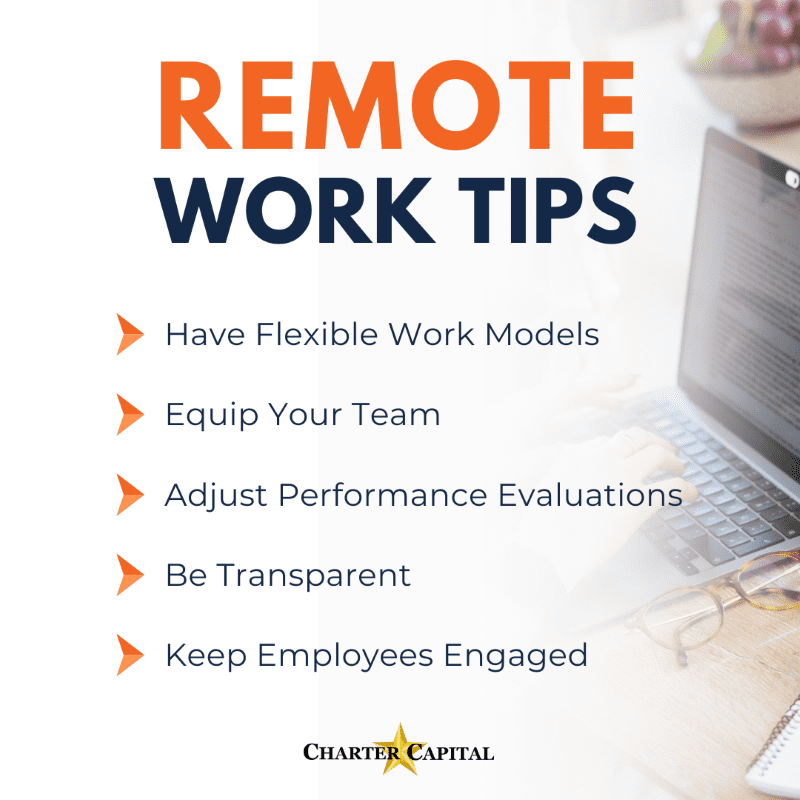
The great “return to office” (RTO) is well underway. A new Resume Builder survey shows that nine in ten employers plan to have return-to-office policies in place by the end of the year. Nearly three in ten say they’re prepared to fire employees who don’t comply with these initiatives. Meanwhile, employees are prepared to push back. Roughly six in ten say they’ll look for new jobs if their ability to work remotely is stripped from them, Forbes research shows.
On this page, we’ll explore some pros and cons of remote work environments and provide tips to keep remote work productivity high if your business plans to stay remote or hybrid.
Pros of Remote Environments
Nearly one in five companies operate entirely remotely, Forbes reports. It’s an option with many benefits for employers and employees alike.
For Employers
Even though there’s a significant movement toward bringing people back to the office, employers receive many benefits by allowing employees to work remotely.
Cost Savings
Employers can save $11,000 for each employee who switches to remote work, Forbes reports. The bulk of the savings come from needing less office space, paired with the diminished resources required to maintain in-person workspaces.
Wider, More Diverse Talent Pool
Brands with remote policies can hire employees from just about anywhere, a shift that widens the talent pool and allows businesses to attract the best talent.
Retention
In all, 98 percent of employees want to work remotely at least some of the time, Forbes reports. By respecting this desire, particularly as more businesses push their return-to-office initiatives on employees, employers have the potential to boost employee retention.
For Employees
Remote work remains the dominant preference for employees, with 65 percent wanting to work remotely all the time and 32 percent preferring a hybrid schedule, per Forbes. While the reasons for this are myriad, a few central themes emerge.
Flexibility
Remote employees can often flex their schedules as needed. This means they can work when they’re most productive, shift their days to accommodate family or work from different locations as needed. Flexible hours are the most-desired fringe benefit of remote work, Forbes reports.
Work-Life Balance
More than 70 percent of remote workers say working remotely allows them to balance their work and personal life better, Forbes research shows.
Perceived Remote Work Productivity
Roughly 35 percent of people feel more productive when working fully remotely, according to Forbes. This can have a major impact on morale and contribute to improved outcomes.
Greater Happiness
Overall, people tend to be happier with remote work arrangements. For instance, a 20 percent uptick in happiness was seen in one study, Forbes reports.
Maximizing Productivity for Remote and Hybrid Workforces
Evidence suggests that remote work significantly benefits both employers and employees, with many employers observing notable productivity improvements when their teams can work remotely. Among remote workers, the flexibility of hours at home and the absence of a commute often translate into higher productivity levels, contrasting the traditional confines of working in an office. Remote workers often report feeling more engaged and productive at home, highlighting the importance of employers learning how to improve support structures for these employees. For full-time workers, the shift to remote or hybrid models has shown that employees’ productivity is not only maintained but often enhanced, with workers becoming more productive than their in-office counterparts. Essential for remote workers is the ability to maintain a work-life balance, manage their productivity at home effectively, and ensure that the hours spent working contribute positively to their professional outcomes. As businesses continue to adapt, the evidence is clear: fully remote workers and those in hybrid arrangements are not only just as productive at home but, in many cases, prove to be more productive than when they worked in the office. By embracing these insights, employers can foster environments where remote and hybrid employees thrive, underscoring the critical shift towards more flexible work paradigms.
Cons of Remote Environments
Despite all the positives of remote work, there are many challenges that businesses and employees must overcome, too.
For Employers
Nearly three-quarters of employers that have already moved their teams back to the office at least part of the time say that it has improved revenue, per Resume Builder. This is likely because the shift eliminates some of the most significant challenges associated with remote work, as covered below.
Maintaining Company Culture
The majority of execs believe that corporate culture accounts for more than 30 percent of their company’s market value, CNBC reports. Maintaining a strong company culture can be incredibly difficult with employees scattered, which may impact value.
Communication Barriers
Pop culture pokes fun at the deluge of Zoom meetings and emails remote employees endure, but the reality is that more than half of all communication is non-verbal, University of Texas research shows. Things like body language and inflection comprise all but seven percent of a message. That means even if your business has systems and tools in place to help streamline communication and help your team collaborate, there will still be difficulties in relaying or interpreting communication most of the time, which diminishes results and can eat away at efficiency.
Performance Monitoring
Around 60 percent of companies use performance monitoring software to track their remote employees, Forbes reports. While they can help keep certain employees on track, they also come with privacy concerns, a monetary investment, and can diminish employee morale.
For Employees
Even though remote is preferred by most employees, it creates challenges for them, too.
Isolation
More than half of all remote workers say it’s harder to feel connected to their coworkers, Forbes reports.
Overworking
Remote work strategies often center on boosting productivity but fail to address how the lines between work and home blur for some employees or how hours worked may dramatically increase for some. Moreover, 69 percent report increased burnout from digital communication tools, according to Forbes.
Employer and Employee Remote Work Tips
If you decide to keep your team working at least partially remotely, the following tips can help.
Find Your Balance
The idea that 90 percent of companies are returning to the office is a bit misleading. Just 19 percent say their employees will be required to attend work in-person five days per week, Resume Builder surveys show. The rest only require their teams to attend in-person some of the time.
You don’t need to be fully remote or entirely in-person. For instance, the top remote jobs, according to Forbes, include:
- Accountant
- Executive Assistant
- Customer Service Representative
- Senior Financial Analyst
- Recruiter
- Project Manager
- Technical Writer
- Product Marketing Manager
- Customer Success Manager
- Graphic Designer
You may want to keep roles like these remote while bringing other roles back to the office or have specific duties that must be performed in the office while allowing remote work the rest of the time.
Incentivize When In-Person is Required
Google made headlines when it announced in-person attendance would become part of its performance reviews. Dubbed the “One thing no company should ever do” by Inc., and the move painted Google in a negative light and gave companies a crash course in how not to handle return-to-office initiatives. Rather than ruling by force, employers do better when providing incentives to encourage employees to return as needed. For instance, 70 percent offer commuter benefits, Resume Builder reports. Catered meals, childcare benefits, and raises also rank high as popular tactics.
Equip Your Team
Ensure your team has the tools it requires to work effectively. This involves things like computers and software, as well as clear expectations.
Adjust Performance Evaluations
Maintaining productivity remotely may not be the problem some business leaders think it is. Countless studies show remote workers are more productive, as Forbes reports. However, it can be difficult for some leaders to gauge productivity when they don’t physically see the employee. It’s also more difficult for some to rate employees fairly when they don’t have regular contact. Developing a fairer review system that relies on data or the attainment of goals may help.
Be Transparent
If tools such as productivity tracking software are required, be transparent about them. Talk to the team about what they track and how they work. This helps eliminate negativity and privacy concerns while allowing employers to obtain necessary data.
Keep Employees Engaged
Even though employees may be remote, they can remain engaged. Teams benefit when employers foster collaborative remote environments, invest in development, provide support through employee wellness programs, and maintain open lines of communication.
Obtain the Working Capital You Need Through Invoice Factoring
Even though going remote can reduce overhead, many companies still experience cash flow gaps, especially as the business grows. Invoice factoring can provide instant payment on your B2B invoices so that you can cover essential expenses such as payroll, equipment for remote employees, and more. To learn more, request a complimentary factoring rate quote from Charter Capital.

- Top 4 Types of Small Business Scams and How to Prevent Them - November 24, 2025
- How to Perform a Cash Flow Stress Test Effectively - October 27, 2025
- Success Metrics for Businesses Using Invoice Factoring - September 1, 2025

